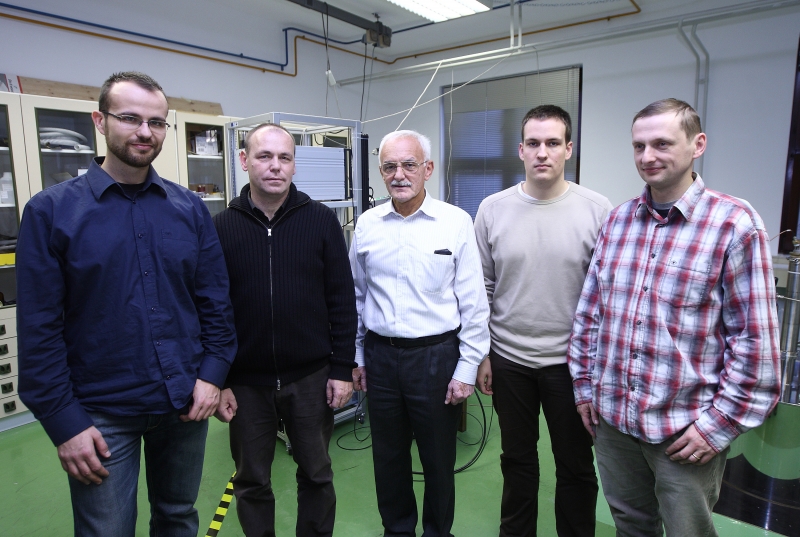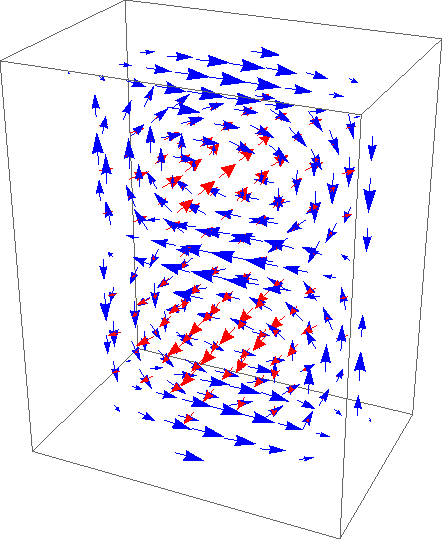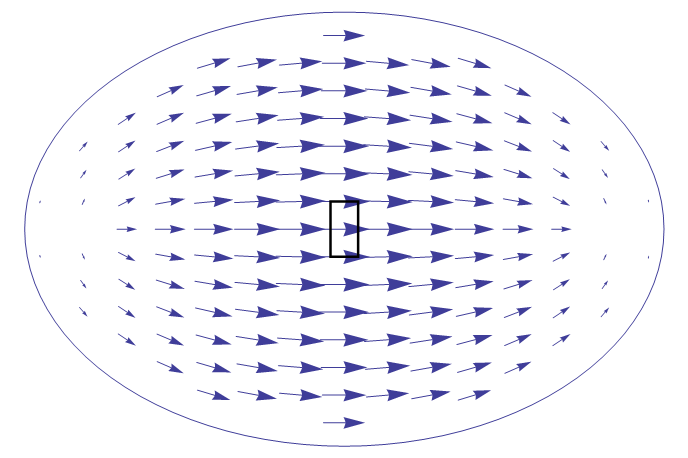General
The microwave absorption laboratory has been founded as a part of the new facilities of the Physics Department at the Science Hill in 1997. It was established by prof. dr. sc. Antonije Dulčić and prof. dr. sc. Miroslav Požek in cooperation with the group of prof. dr. sc. Michael Mehring of Stuttgart (Germany). Ever since it was founded, the group has been researching superconductors – classical BCS and HTSCs. Most of the work has been done on fluctuation effects in cuprates, influence of the magnetic field on suppression of Tc, and effects of reduced dimensions in thin films.
Currently, the microwave absorption measurements are performed by:
prof. dr. sc. Antonije Dulčić adulcic-at-phy.hr
prof. dr. sc. Miroslav Požek mpozek-at-phy.hr
doc. dr. sc. Dalibor Paar dpaar-at-phy.hr
dr. sc. Mihael Grbić mgrbic-at-phy.hr

In photo from left to right: M. S. Grbić, M. Požek, A. Dulčić,
M. Bosiočić (NMR) and D. Paar
We are always open for collaboration and feel free to contact any of us.
Students who wish to gain some knowledge in this technique, make a seminar or a diploma thesis are always welcome – we usually have more ideas than available hands.
Our recent publications are available here
A more concise overwiev of our research topics can be found here:
Fluctuation effects in cuprates - to fully understand the properties of the underdoped region of the cuprates where an energy (pseudo)gap defines the physics of the normal state, we have explored the properties of ac conductivity close to Tc. By varying the strength of the external magnetic field and chemical doping of the system at hand we were able to determine the properties of the fluctuating superconducting order parameter.
Ruthenates - in a hybrid compund RuSr2Gd2Cu2O8 we studied the intriguing properties of coexisting magnetism and superconductivity. By combinig dc trasnport measurements, ac and dc susceptibility and microwave absorption measurements we found a decoupled behaviour of RuO2 and CuO2 planes. While the CuO2 planes form a superconducting state, the RuO2 planes remain in the normal state and order magnetically. From two doping exchange studies: exchanging Sr to La (superconductivity suppressed, magnetism enhanced) and Ru to Sn (superconductivity enhanced, magnetism suppressed) we find evidence of collossal magnetoresistance in the RuO2 planes.
- M. Požek, I. Kupčić, A. Dulčić, A. Hamzić, D. Paar, M. Basletić, E. Tafra, G. V. M. Williams, "Microwave and magnetotransport properties of RuSr 2GdCu2O8 (R = Eu, Gd) doped with Sn", Phys. Rev. B 77, 214514 (2008).
- M. Požek, A. Dulčić, D. Paar, A. Hamzić, M. Basletić, E. Tafra, G. V. M. Williams, S. Krämer, "Decoupled CuO2 and RuO2 layers in superconducting and magnetically ordered RuSr2GdCu2O8", Phys. Rev. B 65 , 174514 (2002).
-
M. Požek, A. Dulčić, D. Paar, G. V. M. Williams, and S. Krämer, "Transport and microwave study of superconducting and magnetic RuSr2EuCu2O8", Phys. Rev. B 64, 064508 (2001).
Finite frequency cutoff - by considering the contributions of the Gaussian processes in the superconducting fluctuations to ac conductivity, we introduce a lower limit for the relaxation time of the charge carriers. Through it, we reveal the finite-size effects in (cuprate) superconductors visible as the relaxation time slows down when approaching Tc.
- D.-N. Peligrad, M. Mehring, A. Dulčić, "Critical fluctuations and pseudogap observed in the microwave conductivity of Bi2Sr2CaCu2O8+δ, Bi2Sr2Ca2Cu3O10+δ, and YBa2Cu3O7-δ thin films", Phys. Rev. B 69, 144516 (2004).
Reduced dimensionality effects in niobium - niobium is a classical BCS type II. supercodnuctor whose properties make it particularly usefull for industrial applications. The large (bulk) coherence length of ~20 nm enables us to observe the change in the properties of the system as the thickness of the film becomes of comparable size. Besides the change in Hc2||, Tc and vortex-depininning frequency, the reduced dimensionality broadens the critical fluctuation region which reveals the properties of the fluctuating order parameter.
Microwave response of materials
Frequency dependant measurements have always been important for studying electrodynamical properties of solids. At low frequencies (kHz up to MHz), one can place contacts on the sample and study the complex response by the use of phase amplifiers, network analyzers, impedance analyzers etc. However those methods are not well suited for measurements at gigaherz frequencies since the wavelength becomes comparable with the cable dimensions, and parasitic capacities and inductivites can screen the sample properties.
Under “microwaves” we consider the electromagnetic waves of frequencies between 1 GHz and 1 THz (higher than radio frequencies and lower than infrared). In experimental solid state physics, the microwave apsorption measurements are useful to study high-frequency transport properties. Frequencies are high enough to avoid the application of electrical contacts, but still low enough to avoid excitations of phonons or e.g. quasiparticles in superconductors.
There are several possible experimental arrangements for the measurements of microwave response of a sample of interest. We use the method of perturbation of a resonant microwave cavity, which is basically a box made of very conducting material whose dimensions are comparable to the wavelength (~3 cm). When in resonance, standing electromagnetic wave is formed in the cavity. When a sample is placed into the cavity, it causes a weak perturbation to the cavity configuration. The resonant frequency and the Q-factor of the cavity are slightly changed. These changes can be measured, and one obtains valuable information about conductivity, permitivity and/or permeability of the studied sample.

Resonant frequency and Q-factor of empty cavity (left) and the change when a sample perturbs the cavity (right)

Distribution of microwave magnetic (blue) and electric (red) fields in a eTE112 mode.
Our microwave cavity

We have constructed an elliptical copper microwave cavity with base dimensions 13x21 mm2, and height 28 mm. The lowest resonant mode is eTE111 with a resonant frequency ~9.5 GHz. In this mode, the sample is at maximum of the microwave electric field. Similarly, for higher modes one can obtain several different polarizations of microwave magnetic or electric field at the sample position.

The fact that the cavity is made of copper enables us to apply an external magnetic field. Sometimes the cavity is made of superconducting material to have lower noise - but in that case one cannot use the magnetic field as probing parameter. Our experimental configuration includes static magnetic field up to 16(18) T. The sample temperature can be varied between 3 and 323 K. This configuration ensures broad phase space for investigation of electric and magnetic properties of materials
Homogeneous distribution of the microwave
magnetic field around the sample volume
The laboratoy has a microwave absorption measurement setup operating at discrete frequencies 9 - 20 GHz (hopefully soon to expand to 35 GHz) which gives us access to four modes: eTE111, eTE112, eTE211 and eTE113. Each mode has a certain distribution of the microwave fields inside the cavity, and by placing the sample in the proper position we can obtain a response to either electric or magnetic driving field.
For more details about the method, please visit the the websites of Dalibor Paar and Mihael Grbić.

 Pristupačnost
Pristupačnost